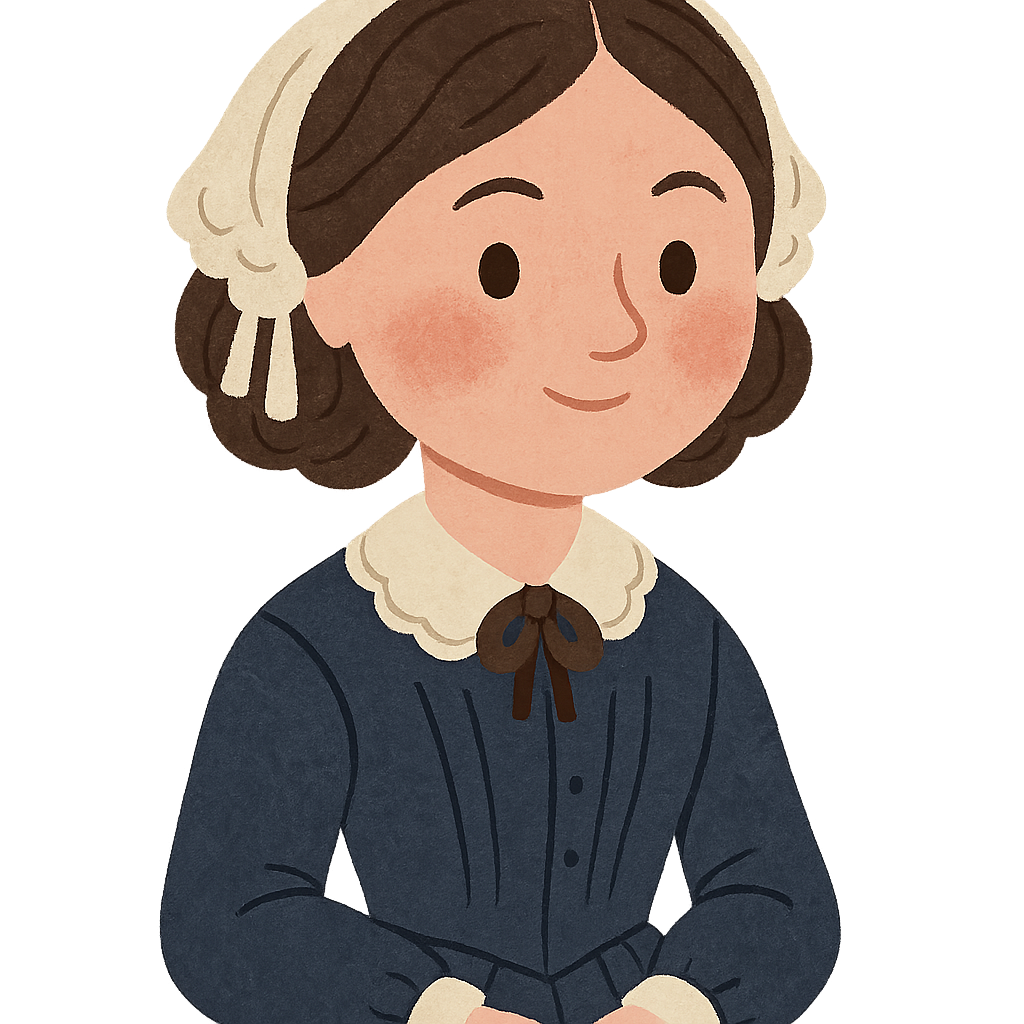Florence Nightingale: The Lady with the Data
Hello, my name is Florence Nightingale, and you may know me as a nurse, but I was also a mathematician and a reformer. My story begins not in England, but in Florence, Italy, where I was born on May 12, 1820. My parents were a wealthy British couple, and they named me after the beautiful city of my birth. We lived a life of great comfort and privilege, moving between our two large estates in England. From a young age, I was expected to follow a very specific path: learn to manage a household, attend elegant parties, and eventually marry a man of high social standing. But I found myself drawn to a different world. While my sister, Parthenope, enjoyed the social whirl, I preferred the quiet of my father's library. He taught me Greek, Latin, history, and mathematics, and I discovered that numbers and data made perfect sense to me. I also felt a deep, unshakeable desire to help others. I would often care for sick animals and tenants on our family's property. Then, in February of 1837, when I was seventeen years old, I felt something I can only describe as a divine calling. I believed God was speaking to me, calling me to a life of service. The idea of nursing began to form in my mind, but in those days, it was not a respected profession. Hospitals were dirty, and nurses were often untrained and considered to be of low moral character. My family was horrified by the idea. For years, I kept my ambition a secret, studying hospital reports and medical texts on my own, preparing for a future that society, and my own family, told me I could never have.
My family's opposition was a constant battle, but I refused to give up my dream. I turned down several marriage proposals, determined to pursue my calling. Finally, in 1851, my father gave me his permission to study nursing. I traveled to Kaiserswerth, Germany, to train at a hospital and school run by Protestant deaconesses. It was the moment my real life’s work began. A few years later, in 1853, the Crimean War broke out between Britain and Russia. Reports from the front lines were horrific. Newspapers wrote about soldiers dying not just from their wounds, but from terrible diseases like cholera and typhus in the overcrowded and filthy military hospitals. My friend, Sidney Herbert, who was now the Secretary of War, knew of my work and wrote to me in 1854, asking me to lead a group of nurses to the Barrack Hospital in Scutari, Turkey. I assembled a team of 38 dedicated women and we set sail. Nothing could have prepared me for what we found. The hospital was a nightmare. It was built over a massive sewer, and the stench was unbearable. Men lay on straw mats in their own filth, rats scurried through the wards, and there were almost no medical supplies, clean bandages, or even decent food. More men were dying from infection than from their battle wounds. I immediately set to work. I organized the other nurses to scrub the wards from top to bottom, established a laundry to provide clean linens, and even set up a special kitchen to cook nutritious meals for the sickest soldiers. It was during this time that I earned my famous nickname. Each night, after the other nurses were asleep, I would walk through the dark, winding corridors, carrying a lamp. I checked on thousands of men, offering them comfort, helping them write letters home, and simply being a reassuring presence. The soldiers began calling me 'The Lady with the Lamp.'
My lamp became a symbol of hope, but my greatest weapon in the fight against death was not compassion alone; it was my mind for mathematics. While I was in Scutari, I didn't just clean the hospital; I collected data. I meticulously recorded the number of deaths and, more importantly, the causes of death. When I returned to England in 1856, I brought my evidence with me. I knew that simply telling people about the horrible conditions wouldn't be enough to create lasting change. I had to show them. Using my mathematical skills, I developed a new type of chart I called the 'polar area diagram,' which you might know today as a pie chart or the 'Nightingale Rose Diagram.' It was a powerful visual tool that clearly showed that the vast majority of soldiers had died from preventable diseases spread by poor sanitation, not from their injuries in battle. The evidence was so clear and shocking that it could not be ignored. I presented my findings to Queen Victoria and government officials, and my work led to a complete reform of the military healthcare system. My efforts didn't stop there. In 1860, using funds raised in my honor, I established the Nightingale Training School for Nurses at St. Thomas' Hospital in London. It was the first professional nursing school in the world, and it transformed nursing into the respected, skilled profession it is today. For the rest of my life, even when an illness I contracted in Crimea left me mostly bedridden, I continued to write books and campaign for public health reform. I passed away peacefully in my sleep on August 13, 1910, at the age of 90. My journey shows that changing the world isn't always about grand gestures. Sometimes, it's about using the unique talents you have—whether it's a comforting hand or a brilliant mind for numbers—to shine a light in the darkest of places.
Reading Comprehension Questions
Click to see answer
